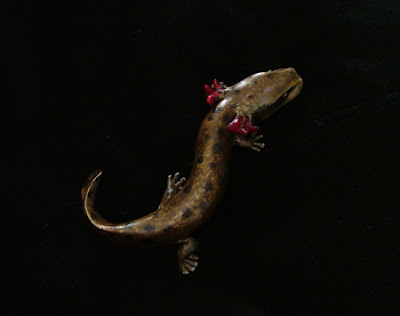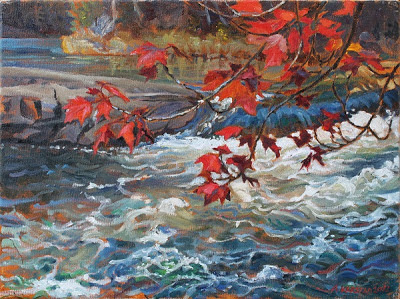Mudpuppy sculpture (acrylic painted polymer clay 6 in.) SOLD!
20 February finds me at the kitchen table with a live Mudpuppy in a shallow basin for reference as I press and smooth with my fingers a handful of flesh-coloured modelling compound. Pictured here is my first finished sculpture, painted yesterday and posed on black velvet for a photo shoot.
The live Mudpuppy becomes restless and starts to splash with its tail, so I return it to the ice-lined bucket with its fellows. Zero degrees is "room temperature" for winter Mudpuppies, and it is at this season that they are most active, feeding and wandering about on the bottom at night. In Oxford Mills they are easily seen by headlamp and searchlight. We have been studying this population every Friday night for 12 years and have not found another site where they are so visible and conducive to long term monitoring and public education. See Mudpuppy Night in Oxford Mills
The four in this bucket will be returned to the icy-banked creek next Friday. They were collected last night by the young naturalists of the Macoun Field Club from Ottawa as they assisted in our weekly count of the giant salamanders that gather in winter below the dam on Kemptville Creek. The Macouns were lucky that the creek hadn't risen too much for Mudpuppy viewing, after our two days of temperatures well above freezing, as when rain falls or snow melts the creek becomes fast, deep, and cloudy with suspended organic material. Many of the Mudpuppies are swept downstream then, and we may not see them again until they make their way back as the water level drops with the return of cold temperatures. Every week brings different conditions and our weekly counts of Mudpuppies vary from none to 180.
The sculpting material Super Sculpey is a polymer modelling "clay" that feels like warmed beeswax to work with. It hardens in 15 minutes when baked at 275F. This flesh-tinted ceramic-like sculpting compound named "Super Sculpey" is a variation on the original white "Polyform" that I used as a teenager. It is still available, under the name of "Sculpey" and is a little softer to work with than "Super Sculpey". I have painted this model with "Tri-Art" acrylic paints, mixing gold and copper colours with brown, black, and pearl, and I'm especially pleased with the red, as it is slightly translucent over the external gills, so that they glow just as those of the live Mudpuppies do when the oxygen is reduced in their water.
Mudpuppies are very adaptable to varying oxygen levels, having lungs into which they gulp air from the surface, and gills which expand and fluff out at need, from finger-like flaps of flesh behind either side of their heads. They also are famous for having more DNA than any other living creature, and the reason for this has been recently explained as allowing the production of enzymes that allow them to be active at a wide range of temperatures, from 30C in summer to 0C in winter, which is their time of greatest activity, having little competition from other scavengers and predators for minnows, crayfish and other small food items on the creek bottom, and also freedom from being predated themselves, as herons have gone south and the larger fish have drifted downstream to where the creek has more oxygen.
The live Mudpuppy becomes restless and starts to splash with its tail, so I return it to the ice-lined bucket with its fellows. Zero degrees is "room temperature" for winter Mudpuppies, and it is at this season that they are most active, feeding and wandering about on the bottom at night. In Oxford Mills they are easily seen by headlamp and searchlight. We have been studying this population every Friday night for 12 years and have not found another site where they are so visible and conducive to long term monitoring and public education. See Mudpuppy Night in Oxford Mills
The four in this bucket will be returned to the icy-banked creek next Friday. They were collected last night by the young naturalists of the Macoun Field Club from Ottawa as they assisted in our weekly count of the giant salamanders that gather in winter below the dam on Kemptville Creek. The Macouns were lucky that the creek hadn't risen too much for Mudpuppy viewing, after our two days of temperatures well above freezing, as when rain falls or snow melts the creek becomes fast, deep, and cloudy with suspended organic material. Many of the Mudpuppies are swept downstream then, and we may not see them again until they make their way back as the water level drops with the return of cold temperatures. Every week brings different conditions and our weekly counts of Mudpuppies vary from none to 180.
The sculpting material Super Sculpey is a polymer modelling "clay" that feels like warmed beeswax to work with. It hardens in 15 minutes when baked at 275F. This flesh-tinted ceramic-like sculpting compound named "Super Sculpey" is a variation on the original white "Polyform" that I used as a teenager. It is still available, under the name of "Sculpey" and is a little softer to work with than "Super Sculpey". I have painted this model with "Tri-Art" acrylic paints, mixing gold and copper colours with brown, black, and pearl, and I'm especially pleased with the red, as it is slightly translucent over the external gills, so that they glow just as those of the live Mudpuppies do when the oxygen is reduced in their water.
Mudpuppies are very adaptable to varying oxygen levels, having lungs into which they gulp air from the surface, and gills which expand and fluff out at need, from finger-like flaps of flesh behind either side of their heads. They also are famous for having more DNA than any other living creature, and the reason for this has been recently explained as allowing the production of enzymes that allow them to be active at a wide range of temperatures, from 30C in summer to 0C in winter, which is their time of greatest activity, having little competition from other scavengers and predators for minnows, crayfish and other small food items on the creek bottom, and also freedom from being predated themselves, as herons have gone south and the larger fish have drifted downstream to where the creek has more oxygen.





http://groups.google.com/group/naturelist/msg/bb58306dfe1d0da9?hl=en%EF%BF%BDb55aaa6&pli=1 and http://groups.google.com/group/naturelist/msg/375685063b55aaa6?hl=en are the narratives of the most recent Mudpuppy Nights.
ReplyDeleteVery cool, Aleta! The mudpuppy is beautiful!
ReplyDeleteFunny little coincidedence. I've just been thinking of getting some polymer clay to do some modeling. Did some reading up on the various products last week and was going to order a couple of kinds to play around with.
I'd definitely recommend the Super Sculpey. It retains your shaping without sagging as you work on it, yet remains flexible enough not to crack when you make adjustments within an hour or so. Very nice feel to it, and doesn't transfer modelling material to your hands. My favorite tool is an African Porcupine quill, the blunt end and the pointed end. After baking it takes acrylic paint very well.
ReplyDeleteOh, one more thing. You can add parts and re-bake as many times as you want.
ReplyDeleteAnd you can include any kind of material that will remain inert at the baking temperature of 275C, like paper, foil, wire, wood, etc. You can build on all kinds of natural objects, and build over armatures for larger pieces.
ReplyDelete